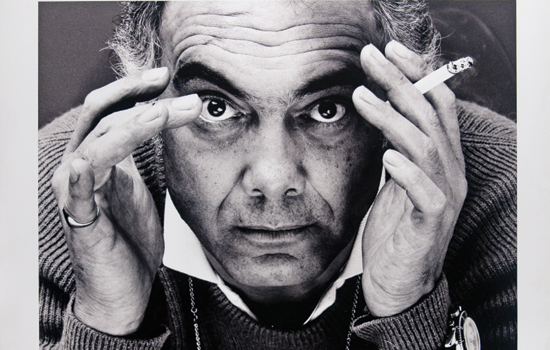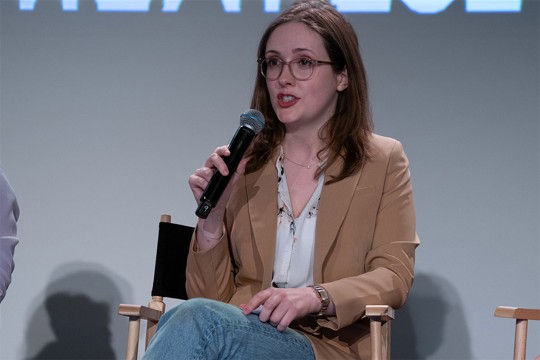Cary Graphic Arts celebrates designer Bob Cato
The public is invited to view the designer’s photographs during debut exhibition April 6-June 26
Cary Graphic Arts Collection
During Bob Cato’s illustrious career as a graphic artist, art director and photographer, he worked at Columbia Records in New York City—designing album covers for legendary performers such as Miles Davis, Barbra Streisand, Bob Dylan and Simon & Garfunkel.
Legendary designer Bob Cato created the “Charlie Girl” image for Revlon, earned Grammys for his Columbia Record jacket designs of Barbra Streisand’s People (1964) and Bob Dylan’s Greatest Hits (1967) and photographed a veritable who’s who of top recording artists of the 20th century—many of whom were his personal friends.
Cato’s (1923-1999) legacy as a graphic artist and photographer lives on as the Cary Graphic Arts Collection at Rochester Institute of Technology celebrates its newest acquisition to join the university’s Cary Graphic Design Archive.
Appraised at $460,000, the “Bob Cato Archive” contains a record of the art and design of Cato in all formats. The collection includes 457 photographic images (353 in black and white, 104 in color), framed and unframed paintings, sculpture, collages, sketchbooks and drawings, books, magazines, album covers and personal memorabilia.
In a public debut, the Cary Graphic Arts Collection is hosting an exhibition, “Musicians: Photographs by Bob Cato,” at RIT’s University Gallery, James. E. Booth Hall. The show will run from April 6 through June 26, with an opening reception scheduled for 5 to 7 p.m. Thursday, April 16.
Cato revolutionized album cover designs in the 1960s during his 10 years as vice president for creative services at CBS-Columbia Records. It was his idea to put the work of underground illustrator Robert Crumb on Janis Joplin’s Cheap Thrills, which later became No. 9 on Rolling Stone’s list of 100 greatest album covers. During his 50-year career as a graphic artist and designer, he built a diverse résumé, working at Glamour and McCall’s magazines, and later at his own business, Bob Cato & Associates, where he was art director for George Harrison’s Dark Horse Records.
Steven Galbraith, curator of the Cary Collection, said Cato’s photographs, fine art and working papers document a rich career in the graphic arts that will inspire generations of future designers—including his signature photographs of Miles Davis, Lena Horne, John Coltrane, Cream, Simon & Garfunkel, Joan Baez, Mitch Miller, Eric Clapton, Johnny Mathis, and Blood, Sweat and Tears.
“What is extraordinary about Cato’s music photography is the range of the artists he captured,” Galbraith explained. “Igor Stravinsky, Louis Armstrong, Muddy Waters, Bob Dylan—these are the greats of their respective genres. It’s like a lesson in 20th century music history presented by an artist who really understood and admired his subjects.”
He also had a strong RIT connection—a personal friendship with R. Roger Remington, Vignelli Distinguished Professor of Design who founded RIT’s Graphic Design Archive in 1984. The two met five years later when Remington was doing research for his first book, Nine Pioneers in American Graphic Design, which included a chapter on Alexey Brodovitch.
“Bob studied under Brodovitch and worked as his assistant at Harper’s Bazaar in the late 1940s,” explained Remington. “So I contacted him in New York and he opened all kinds of doors for me—helped me get interviews with photographers Irving Penn (Vogue) and Richard Avedon (The New Yorker). We ended up becoming close friends, and included in our group was art director Frank Zachary from Town and Country Magazine.”
Often described as congenial and outgoing, Cato was also recognized for his caring and giving personality. When he came to Rochester as a visiting lecturer at RIT, he would never turn away a student in terms of looking at their portfolio and trying to help them get a job.
“Students were engaged by his creativity, and although Bob was very much a formalist in his design sensibilities, his groundbreaking album covers at Columbia Records launched him into an important form of contemporary art,” said Remington. “For those lucky enough to know and work with him, he had this tremendous talent and eye for editorial photography that is no longer known by many in the graphic design and magazine worlds.
“That’s why it’s important to preserve the Bob Cato Archive at RIT. We need to keep these pioneers in the present and not lost in the past.”
For information on the Bob Cato Archive and the accompanying exhibition, “Musicians: Photographs by Bob Cato,” contact Steven Galbraith at 585-475-3961 or skgtwc@rit.edu.















